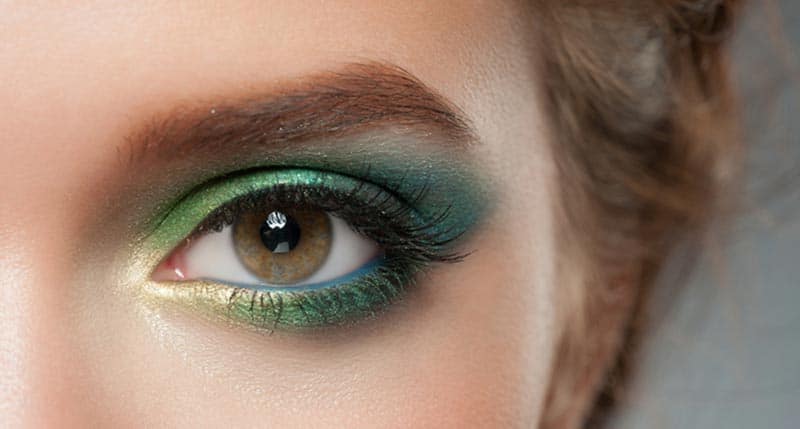
05 Mar 6 Eye Makeup Safety Tips For Healthy Eyes
March is “Save Your Vision” month, encompassing every aspect of eye health. On a daily basis, you must protect your eyes from various potential hazards – UV rays from the sun, eyestrain from digital screens, and environmental hazards such as projectiles and dust. But there’s another potential culprit that many of us apply to our delicate eye area every day. That’s right: We’re talking about eye makeup.
Most cosmetics from reputable manufacturers are safe when properly applied, but be aware of application injury (ouch!), color additives, and the increased risk of eye infections.
Let’s have a “look-see” at some of the “Do’s and Don’ts” of wearing makeup and keeping your eyes healthy. Makeup trends come and go, but protecting your precious sense of vision is forever.
- Clean Up Your Act
Misuse of eye cosmetics can be dangerous – plus there’s an “ick factor” to nasty bacterial or fungal eye infections. Not a good look for your wedding, job interview, or family photo! Remember these safety tips to help reduce the risk of contamination and injury.
- Never share eye cosmetics with anyone – including “testers” in department stores. Sharing another person’s bacteria is never a good idea. Having a makeup salesperson give you a new look may take on a whole new meaning when they use the same products they used on their last makeover client. Whether it’s a friend, family member, or random cosmetic shopper, it is hazardous to swap or share makeup.
- Don’t use old or outdated mascara. After three months of use, pitch it. And don’t ever attempt to remoisten dried-out mascara with water or saliva. That’s a bacterial disaster waiting to happen!
- Store cosmetics at room temperature. Higher temps cause deterioration of the preservatives, so leaving cosmetics in your hot car or beach bag is a definite no-no!
- Your hands are a playground for bacteria. Always wash your hands with soap and water (not hand sanitizer) before applying cosmetics. It’s a good idea to cleanse your face as well. Transfer of bacteria from hand to eye is one of the most common avenues of inflammation, injury, and infection.
- Liquid or creamy eye makeup is especially susceptible to bacterial growth. Be extra-careful with such formulations.
- Use cosmetics for their intended purpose. While it can be tempting to use a lip liner as an eyeliner, you risk cross-contamination. Also, color additives not intended for the eye area can cause inflammation or irritation.
- Don’t Move
As convenient as applying makeup “on the go” may be – don’t risk it! On the bus, in the car, or on a subway is not the ideal scenario to hold a pointy mascara wand near your eyes. A pothole, sudden stop, or rear-end collision could cause you to scratch your cornea, causing a painful injury or infection. Even a grazing scratch with a mascara wand, eyeliner, or tweezer can cause eye injury. It’s not worth the risk.
- False Eyelashes and Extensions
False eyelashes and extensions are trendy but can affect your vision when misused. The FDA considers these products, including lash adhesives, as cosmetic products. Therefore, they must adhere to FDA labeling and safety requirements. However, adhesives can be properly labeled and still cause problems with the eyes and the delicate skin surrounding them. After all, it’s glorified glue! Reactions may be allergic in nature, or the glue may cause irritation that can be very uncomfortable. If you experience a particularly bad reaction — one that causes blurry vision, intense itching, or cracked skin — contact your optometrist for evaluation.
- Dying and Tinting Eyelashes and Brows
Want dramatic dark lashes and brows that accent your eyes? Lash and brow dying or tinting should be done by a licensed professional using FDA-approved products. Serious eye injury, including blindness, has been reported from the use of non-FDA-approved products.
- Avoid Glitter Makeup
Corneal irritation and infection can be caused by sparkle powder, glitter or metallic eye makeup. These relatively large particles act like sand or dirt in the eye, irritating and damaging your eye. Contact lens wearers are especially susceptible to this type of eye makeup injury because the glittery flakes can lodge between the eye and the lens, causing prolonged abrasion and injury.
- Take it Off
The cardinal rule of wearing makeup? Always (always!) remove all makeup before going to sleep. It’s that simple. If not removed, eye makeup can cause follicular conjunctivitis and styes, eyelid cysts, and blepharitis (inflammation of the eyelid that affects eyelashes and tear production). To avoid an eye infection, try these gentle eye makeup removers:
- Vaseline is a soothing and lubricating makeup remover, since it prevents pulling and scrubbing as the makeup slides off gently.
- Tear-free baby shampoos are another great choice because of their hypoallergenic, gentle-to-the-eye formulation. Put a small dab on a cotton ball, close your eyes, and gently wipe.
- Out of eye makeup remover? Baby oil, olive oil, almond oil, or coconut oil are great natural options.
- Makeup removers designed specifically for the eyes are a smart choice, too. Be careful to keep the remover from getting into your eyes. After use, thoroughly rinse any remover off your eye and wipe with a clean cotton pad. Be gentle with those delicate eyelashes – they serve the vital purpose of protecting your eyes from dirt and dust.
Now go out and wow the world with those beautiful, healthy eyes!



Sorry, the comment form is closed at this time.